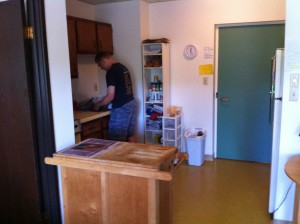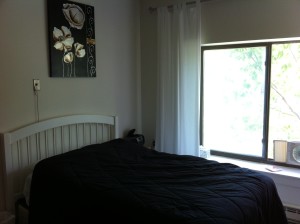Project-based is the easiest to get and is, as the name suggests, usually associated with multi-unit housing complexes. “The subsidy stays with the unit,” according to Housinglink.org. “When you move out, you no longer have the rental assistance” associated with that building.
To be eligible, an individual or family must qualify as “low income,” which means the household cannot exceed 50% of the local median income.[2] Meeting that standard may not be enough, however: “According to federal law, 75% of Section 8 vouchers must go to households with incomes below 30% of the area median income.”[3]
Once an individual is determined to be eligible for project-based Section 8, the tenant is responsible for paying 30% of their income toward the rent. HUD, the Department of Housing and Urban Development, pays the rest to the landlord. Rents are set to be consistent with “moderately priced rental housing in the community.”[4]
Okay, so let’s take Jason as an example. Last year Jason got $812 a month in SSDI, Social Security Disability Insurance. (Jason is eligible for SSDI because Steve (Dad) is on Social Security. If neither you nor your child’s other parent are on Social Security yet, and your child is 18 or older and has a qualifying disability, your child is likely eligible for SSI, Supplemental Security Income.)
Jason also made money at his job as a baker, and we provided evidence of this income through pay stubs. Between the Social Security and employment income, it was determined Jason’s rent in his housing complex would be $270 a month in 2014. That includes heat and electricity.
Not bad! Jay’s been in his lovely one bedroom apartment in downtown Bath for three years now. Each year the landlord requires updated evidence of income, and each year that has meant Jason’s rent has gone up a bit. That’s good news! It means both Jason’s Social Security and his employment income went up those years.
Although we didn’t have to, we chose a project-based Section 8 housing complex reserved for individuals who are elderly or disabled. Because of this, we figured Jay would be living with a tame crowd; I mean, how rowdy can the elderly and disabled be, compared to the general population on Section 8? Ooooh, those are stories for another day . . . not rowdy, exactly, but . . . interesting.
Why did we go down this path in the first place? We kind of fell into it. It all started when we began thinking about college . . . we were thinking of STRIVE University . . .
A program of PSL Services in Portland, STRIVE U’s mission is to provide “education and training to young adults with developmental disabilities in the realms of residential, employment, and community skills, with the goal of enabling its graduates to live and work as full community members with maximum independence and productivity.”[5]
Wow, we thought, that’s perfect for Jason. Students live in dorms, which “serve as classrooms for independent living, training in money management, time management, independent travel, self-care, nutrition, health and wellness, and household management. Each resident [has] maximum independence and choices, including the opportunity to make mistakes in a safe environment.”[6]
Students are also “given the opportunity to experience a wide variety of employment opportunities of value to both the employer and the employee, focusing on areas in which students express interest.”
As if that wasn’t enough, a partnership with Kaplan University helps students “identify personal and academic goals and how to meet their goals through collegiate academics. STRIVE U students have a Kaplan University student identification card, and have full access to campus life, including recreational and social facilities, participation in intramural sports, admission to sanctioned clubs and unions, and other non-academic programs.”
And finally, to put the icing on the cake, STRIVE U also helps students transition into community housing and employment, where they will become “productive and fully participating members of the community.”
We visited this amazing program, and it exceeded our expectations. The students we so self-assured, so animated, so involved, we knew this was the perfect place for Jason. He’d love it. Despite some of my concerns, staff assured us they’d never lost a student yet 😉
Yes! That’s exactly what Jason needed.
There was just one problem: “STRIVE U is harder to get into than Harvard,” William Shuttleworth, the former Superintendent of Bath Schools once told me. William was right. Strive University accepts only seven students a year.
Jason applied, but he didn’t get in. Rats. Now what? Graduation was looming. And boy, was Jason disappointed.
So . . . the more we looked at that brick Section 8 housing project for the elderly and disabled in downtown Bath, the more we convinced ourselves it looked just like . . . a dorm. Hmmm. When Jason applied, the tuition to STRIVE U was around $13,000 a year. Let’s see, Section 8 at $270 a month . . .
We could teach Jason how to do “money management, time management, independent travel, self-care, nutrition, health and wellness, and household management”; “experience a wide variety of employment experiences”; and pretty much everything STRIVE U intended to do.
And that is what we proceeded to do. When Jason moved in, we called the building “the dorm.” He learned to use the coin operated machines to do his laundry, create and shop for meal plans, live within his budget, care for his car, have a job and enjoy town events (Heritage Days over the 4th of July week is a favorite, including walking to the waterfront to see the fireworks.)
The early days were not without their hiccups, and in case you’re thinking of doing something similar with your loved one, let me give you some heads-up. We explained the new dorm was Jason’s new home. We impressed upon him how important it was to keep his door locked, because that was an important part of safety. We taught Jay how to do laundry at the complex before he moved in, and made sure he moved in with a sufficient supply of quarters. For reasons I cannot explain, Jason decided the very first activity he would engage in, as a young man now living on his own, was laundry. (What laundry? Who has laundry on their first night away from home?) Jason decided to do laundry first thing, right after he made himself at home by stripping down to his underwear. Alas, we had neglected to point out that while one might wander around in his underwear in the comfort of his own home, the comfort of his own home did not now extend to the common areas of a Section 8 housing complex. Moreover, as you might anticipate, underwear does not have a niche for apartment door keys or a smart phone, so Jason accidentally locked himself out of his unit. In his underwear.
Thankfully, a neighbor kindly invited Jason in and allowed him to use her phone to call us. We arrived promptly with a spare key, and all seemed to get back on track. Lesson learned.
A month or so later we arrived at Jason’s apartment with a care package, and we noticed his laundry waiting outside his apartment door, all neatly folded. Too neatly folded. No way Jason folded that laundry. And besides, it was Tuesday. Tuesday isn’t laundry day, Monday is (trust me, it’s always Monday.) Why . . . . ? How . . . ?
Jason opened the door and nonchalantly scooped up the laundry. He didn’t have the skills to explain it, exactly, but we found out that Jason learned if he left his clothes in the dryer, if he “forgot” them, one of the elderly ladies (“dorm mates,” we called them) would fold each and every clearly “young man” piece of clothing (Jason was at the time the only “young man” in the building), and leave them at his door. All that was missing was a mint and scented sachet.
Imagine that—Section 8 housing with concierge service.
Gotta love it.[7]
[1] “Section 8” refers to a section of the Housing Act of 1937, which has been amended and amended and amended. . .
[2] Section 8 Made Simple; http://www.tacinc.org/knowledge-resources/publications/manuals-guides/section-8-made-simple/
[3] Section 8 Made Simple
[4] Section 8 Made Simple
[5] http://www.pslstrive.org/strive_mission
[6] http://www.pslstrive.org/Curriculum
[7] Jason has since been taught that leaving one’s laundry in the dryer is, well, rude. And the elderly ladies have been taught not to fold his laundry ;-).




Such a great story about becoming independent! Jay has outdone himself all along the way!
Oh my goodness,,, my son loves being in his underwear,, he would have so done that!!!! Thank u for sharing!!